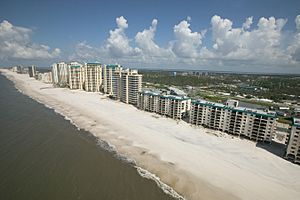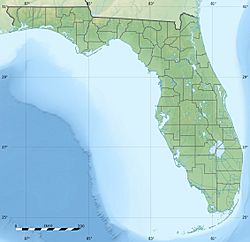Perdido Key, Florida facts for kids
Quick facts for kids
Perdido Key, Florida
|
|
|---|---|

Perdido Key, July 13, 2005. Impact of Hurricane Dennis
|
|
| Nickname(s):
Perdido, The Key
|
|
| Country | United States |
| State | Florida |
| County | Escambia |
| Time zone | UTC-6 (CST) |
| Area code(s) | 850 |
Perdido Key is a special place in Florida, United States. It's a small community located on a barrier island between Pensacola, Florida and Orange Beach, Alabama. The name "Perdido" means "lost" or "hidden" in Spanish and Portuguese. This narrow island is about 16 miles (26 km) long. A big part of it is protected as part of the Gulf Islands National Seashore, which helps keep its natural beauty safe.
Contents
History of Perdido Key
Long ago, in the 1600s, explorers from Spain and France came to the northern coast of the Gulf of Mexico. They were looking for new lands and riches. Both countries wanted to control this area. Spanish explorers settled near what is now Pensacola, Florida. The French started a settlement near Mobile, Alabama.
Finding the "Lost" Bay
Explorers from both countries heard stories about a large, mysterious body of water west of Pensacola. But they couldn't find the entrance to it. In 1693, a Spanish mapmaker and scientist named Carlos de Sigüenza y Góngora was sent to find this hidden entrance.
Legend says that Siquenza's ship was blown off course while he was searching. An Indian chief spotted his ship and offered to guide him to a deep water channel. When they finally found the hidden bay, they called it Perdido. This means "lost" or "hidden" in Spanish.
How the Island Changed
Early maps show that the entrance to Perdido Bay was once right on the border between Alabama and Florida. Over time, strong storms like hurricanes and other natural forces have moved the entrance. Today, it's about 3 miles (4.8 km) from the Florida border, in Orange Beach, Alabama.
Perdido Key became an island around 1933. Before that, it was a small peninsula connected to the mainland. A narrow ditch, sometimes full of alligators, separated it. This ditch was later made wider and deeper to become part of the Intracoastal Waterway. This important waterway connects Pensacola to Mobile Bay.
A Special Beach and a Hero
For many years, some beaches in Florida were only for certain groups of people. What is now the Gulf Islands National Seashore was one of the few beaches near Pensacola that was open to African Americans.
Honoring Rosamond Johnson Jr.
A young soldier named Rosamond Johnson Jr. was the first person from Escambia County to die in the Korean War. He was only 17 years old when he died on July 26, 1950. He was a true hero, saving two wounded soldiers before he was fatally injured while trying to save a third. He received the Purple Heart medal after his death.
At the time, beaches in Pensacola were separated. The Gulf beach area was a popular spot for African Americans. After the Korean War, a local club suggested renaming this county-owned beach to honor Rosamond Johnson Jr. The area became part of Gulf Islands National Seashore in 1973, and the name Rosamond Johnson Beach stayed. A monument was built in his honor in 1996.
Geography of Perdido Key
Perdido Bay once had many natural springs bubbling up from its sandy bottom. When the Lillian bridge was being built, engineers found that the bridge supports would sink because of these soft spring areas. They had to build special structures to make the supports strong.
The Intracoastal Waterway
The Intracoastal Waterway (ICW) is a big channel that connects Pensacola to Mobile Bay. It was dug between 1931 and 1933. This digging created Perdido Key Island, separating it from the mainland. Today, Perdido Key is about 16 miles (26 km) long. Almost 60% of the island is protected in federal or state parks.
In 1978, the National Park Service bought over 1,000 acres (4 km²) of land on Perdido Key. This area used to be called Gulf Beach, but over time, it became known as Perdido Key.
How Hurricanes Change the Island
Hurricanes can really change the shape of barrier islands. For example, in September 2020, Hurricane Sally hit Perdido Key. It split a part of the undeveloped island into three smaller islands. This shows how powerful nature can be.
Environment and Wildlife
Perdido Key is a favorite spot for environmentalists and outdoor lovers. It has miles of protected beaches and wilderness. Along with Navarre Beach Marine Park and the Gulf Islands National Seashore, these protected coastlines are a key feature of the Pensacola Bay area.
You can enjoy hiking, kayaking, and bird watching here. There are also tours to see dolphins and go sailing. If you're lucky, you might spot gray foxes and blue herons in the wild. Local guides offer tours, or you can explore nature trails at Big Lagoon and Johnson Beach on your own.
Perdido Key Beach Dune Habitat
The beautiful white sand beaches and blue waters of the Gulf of Mexico are home to many plants and animals. The beach dune habitat has rows of sand dunes. The front dunes are covered with grasses like sea oats, which help hold the sand in place. Further inland, you'll find plants like saw palmetto and pine trees.
These plants are super important for the health of Perdido Key's beaches. Their roots act like "fingers" that keep the sand from blowing away in the wind or washing away during storms like hurricanes. Without these dunes and their plants, the beaches would disappear.
A project on Perdido Key is working to restore and plant native plants. Some of these include:
- Sea oats
- Saltmeadow cordgrass
- Coastal panicgrass
- Turtle grass
- Salt marsh cordgrass
- Black needle rush
Wildlife of Perdido Key
Perdido Key is home to the endangered Perdido Key beach mouse. This tiny mouse is white and gray, weighing only about 13-16 grams. Its colors help it blend in with the white sand. It mainly eats seeds from sea oats, but sometimes it eats insects too.
The Perdido Key beach mouse was listed as an endangered species in 1985. The biggest problem for them is losing their habitat because of new buildings. Hurricanes also cause problems. After hurricanes Erin and Opal in the mid-1990s, there were fewer than 40 mice left. But they have recovered well, with about 500 now! Even though their numbers are growing, they will likely stay on the endangered list because of ongoing habitat loss.
Sea Turtles and Their Life Cycle
Other animals also love the white sands of Perdido Key. Piping plovers and sea turtles visit seasonally.
Sea turtles are another endangered visitor. Loggerhead, leatherback, ridley, and green sea turtles come to Perdido Key between May and September. They dig nests in the sand and lay 100 or more eggs. About two months later, if the nest is safe, tiny turtle hatchlings emerge.
These hatchlings try to find the brightest spot in the sky, which is usually the horizon over the water, and scramble to the sea. But with more buildings on the island, lights from stores and hotels can confuse them. This makes their journey to the sea very dangerous. Very few hatchlings survive their first year and grow old enough to return to Perdido Key to lay their own eggs.
Birds and Butterflies
Many shorebirds, like black skimmers, gulls, terns, and brown pelicans, rest, nest, or feed near the island. Neotropical birds, such as warblers and cedar waxwings, travel from the tropics to North America to breed. They stop at Perdido Key to feed and rest.
Monarch butterflies also stop here during their long migration to and from South America. They find refuge on the sea oats growing in the dunes.
Fun Things to Do in Perdido Key
To the south of Perdido Key, you'll find the beautiful Gulf of Mexico with its white sand beaches and clear blue waters. To the north are Old River and the Intracoastal Waterway. Just north of Old River is Ono Island, a private community.
Most of these waterways are great for boating. They lead to the Gulf of Mexico through the Alabama Pass or the main harbor entrance of Pensacola Pass. The inland waterways have always offered protection from storms. Many homes in this area are right on the waterfront.
Gulf Islands National Seashore / Rosamond Johnson Beach
This area is on the eastern end of Perdido Key. It's open from 5 a.m. to 8 p.m. You can find picnic shelters, restrooms, showers, and lifeguards during certain seasons. The historic Fort McRee is at the very eastern tip, but you can only reach it by boat or by walking.
On the Sound side, there's a half-mile nature trail that goes through a salt marsh and a forest. This trail is wheelchair accessible. (Note: The Nature Trail has been closed since September 2020 due to hurricane damage).
Safety Tips for Visitors:
- The sunlight reflecting off the white sand can be very bright.
- Biting insects can be present, especially around dusk.
- The sand along the Gulf side can be loose and hard to walk in.
- Winds can get strong at night, so secure your belongings.
- Temperatures can drop, even in summer, so bring layers.
- Always check surf warnings! Two red flags mean the water is closed. A purple flag means dangerous sea life like sharks or jellyfish are present.
- Rip currents are common, especially after storms.
- If you have small children, it's best to stay in the main pavilion area where lifeguards are on duty. Lifeguards are usually on duty from Memorial Day weekend through Labor Day weekend.
Big Lagoon State Recreation Area
This park is named after the nearby Big Lagoon. It covers 678 acres (2.7 km²) and opened in 1978. You can find many birds and animals here, like gray foxes, raccoons, skunks, and great blue herons.
The park has over 75 campsites and five picnic areas with shelters. There's also a large outdoor theater, a boat ramp with a dock, boardwalks, and nature trails. An observation tower offers amazing views of Big Lagoon, the park, and Gulf Islands National Seashore. It's located at 12301 Gulf Beach Highway, Pensacola, just north of Perdido Key.
Perdido Key State Recreation Area
The Perdido Key State Recreation Area covers 247 acres (1 km²) on the barrier island. This island helps protect the mainland from strong winds and tides. It also provides a home for shorebirds and other coastal animals.
If you want to fish in saltwater, you'll need a license. Remember, if you find a shell with an animal living inside, leave it alone! The wide white sand beaches and rolling dunes covered with sea oats make this a beautiful, untouched place in Florida. Picnic shelters are located between the Gulf and the Old River, which is on the north side of Perdido Key.
Images for kids



